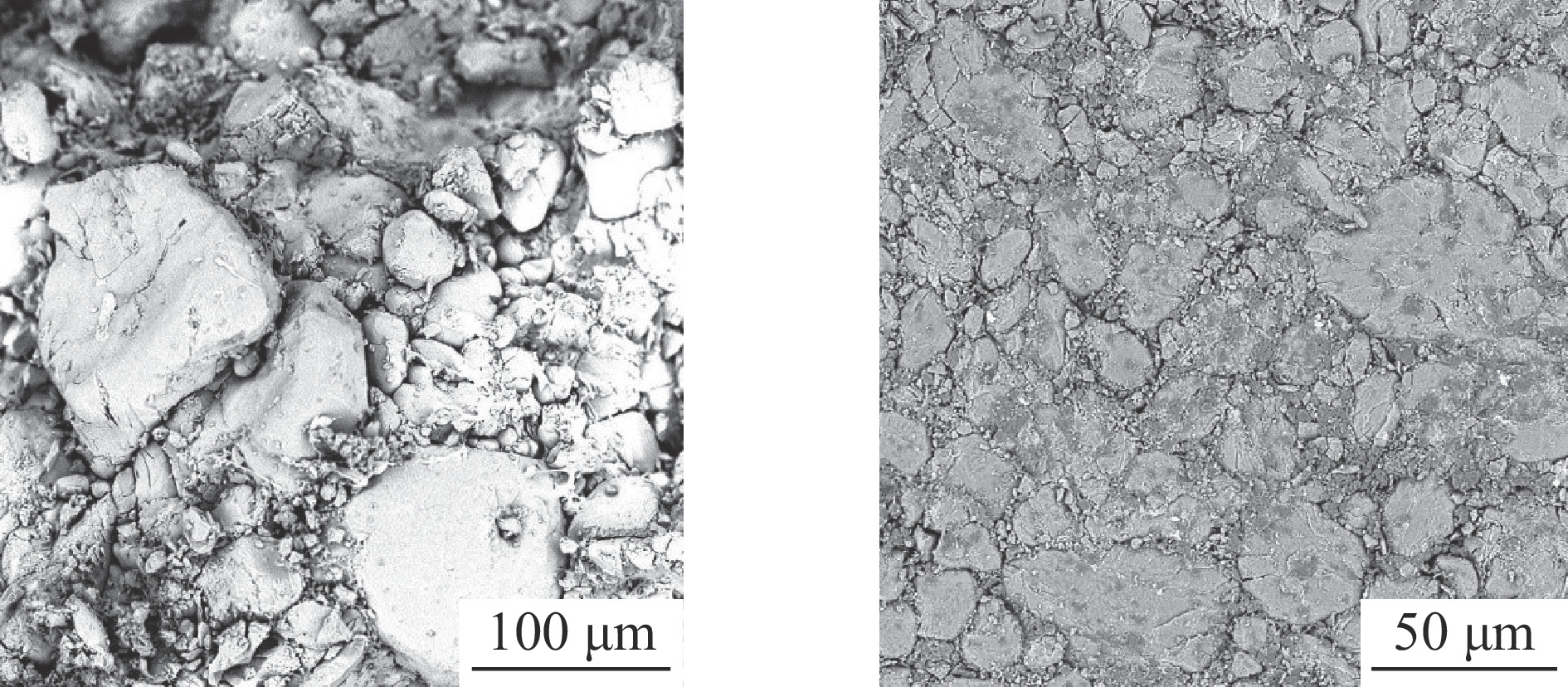Study on mechanical properties and damage characteristics of booster explosives under static compression
-
摘要: 为研究聚黑-14C(JH-14C)传爆药静态压缩力学性能及损伤特性,开展准静态压缩实验,获得了不同应变率下的应力-应变曲线,建立了描述不同应变率下JH-14C力学行为的非线性本构模型;利用扫描电镜(SEM)对回收试样进行细微形貌观测,获得了准静态压缩JH-14C损伤特性的表征。结果表明:JH-14C压缩强度随应变率的升高而提高;实验与计算结果对照验证了本构模型的有效性;准静态压缩实验中,JH-14C主要损伤模式为脱湿和穿晶断裂。Abstract: In order to study the static compression mechanical properties and damage characteristics of the JH-14C booster explosive, quasi-static compressive experiments were performed on a testing machine equipped with an environmental chamber (INSTRON). According to the GJB 770B–2005 powder test method, dimensions of the cylindrical specimen were set as
$\varnothing $ 12.5 mm×12.5 mm in the static compressive experiments. During compression, only one extensometer was used. All experiments were performed at a crosshead speed of 0.012 5, 0.062 5, 0.125, 0.625 and 1.25 mm/s at room temperature (25 °C), which led to a nominal strain rate of 0.001, 0.005, 0.01, 0.05 and 0.1 s−1, respectively. The average stress-strain values and standard deviations were calculated using five replicable experiments for each condition. The experimental results were compared with X0242 and PBX-9501, and the mechanical properties of JH-14C were analyzed. According to the mechanical properties of JH-14C at low strain rates, the original Ramberg-Osgood constitutive relationship was modified, and a nonlinear constitutive model including the strain rate term was established to describe the mechanical behavior of JH-14C at low strain rates. The micro morphologies of the recovered samples was observed by a scanning electron microscope (SEM) and compared with that of PBX-9501. The damage mode was analyzed to characterize the damage characteristics of JH-14C under quasi-static compression. The results show that the compressive strength of JH-14C increases with the increase of strain rate. The validity of the constitutive model was verified by comparing the experimental and calculated results. In the quasi-static compression experiments, the energetic particles and the binder were debonded. With the increase of the pressure, the original crack and the micro-crack formed by debonding on the energetic particles were converged and coalesced to form a macro crack, which led to the rupture and failure of the explosive.-
Key words:
- JH-14C /
- booster explosive /
- quasi-static /
- strain rate /
- constitutive model /
- damage mode
-
表 1 模型拟合结果的相关系数
Table 1. Correlation coefficients of the model fitting results
$ \dot \varepsilon$/s−1 R2 0.1 0.990 5 0.05 0.997 5 0.01 0.998 7 0.005 0.992 5 0.001 0.984 2 -
[1] 邓琼, 叶婷, 苗应刚. 基于Hopkinson压杆实验技术研究火工品及含能材料的抗高过载能力 [J]. 火炸药学报, 2009, 32(6): 66–70. DOI: 10.14077/j.issn.1007-7812.2009.06.019.DENG Q, YE T, MIAO Y G. Study on overloading-resistibility of initiator and energetic materials based on the technique of Hopkinson pressure bar [J]. Chinese Journal of Explosive & Propellants, 2009, 32(6): 66–70. DOI: 10.14077/j.issn.1007-7812.2009.06.019. [2] RAE P J, PALMER S J P, GOLDREIN H T, et al. Quasi-static studies of the deformation and failure of PBX 9501 [J]. Proceedings of the Royal Society A: Mathematical, Physical and Engineering Sciences, 2002, 458(2025): 2227–2242. DOI: 10.1098/rspa.2002.0967. [3] RAE P J. Quasi-static studies of the deformation, strength and failure of polymer bonded explosives [D]. Cambridge, UK: University of Cambridge, 2000. [4] RAE P J, GOLDREIN H T, PALMER S J P, et al. Quasi-static studies of the deformation and failure of β-HMX based polymer bonded explosives [J]. Proceedings of the Royal Society A: Mathematical, Physical and Engineering Sciences, 2002, 458: 743–762. DOI: 10.1098/rspa.2001.0894. [5] HEIDER N, STEINBRENNER A, AURICH H, et al. A method for the determination of the viscoelastic relaxation function of reactive materials [J]. The European Physical Journal Special Topics, 2016, 225(2): 397–407. DOI: 10.1140/epjst/e2015-66666-x. [6] HEIDER N, STEINBRENNER A, WEIDEMAIER P, et al. Modelling the mechanical behaviour of PBX KS32 [C] // 44th Annual Conference ICT. Karlsruhe, Germany: Fraunhofer Institute for Chemical Technology, 2013. [7] DIENES J K, ZUO Q H, KERSHNER J D. Impact initiation of explosives and propellants via statistical crack mechanics [J]. Journal of the Mechanics and Physics of Solids, 2006, 54(6): 1237–1275. DOI: 10.1016/j.jmps.2005.12.001. [8] BENNETT J G, HABERMAN K S, JOHNSON J N, et al. A constitutive model for the non-shock ignition and mechanical response of high explosives [J]. Journal of the Mechanics and Physics of Solids, 1998, 46(12): 2303–2322. DOI: 10.1016/S0022-5096(98)00011-8. [9] 李硕, 袁俊明, 刘玉存, 等. 聚黑-14C的传爆装置冲击起爆实验及数值模拟 [J]. 火炸药学报, 2016, 39(6): 63–68,79. DOI: 10.14077/j.issn.1007-7812.2016.06.011.LI S, YUAN J M, LIU Y C, et al. Experiment and numerical simulation of shock initiation of JH-14C detonation device [J]. Chinese Journal of Explosives & Propellants, 2016, 39(6): 63–68,79. DOI: 10.14077/j.issn.1007-7812.2016.06.011. [10] 董理赢. 引信传爆序列殉爆反应特性研究 [D]. 太原: 中北大学, 2020. DOI: 10.27470/d.cnki.ghbgc.2020.000896.DONG L Y. Study on the characteristics of the sympathetic detonation reaction in fuze explosive trains [D]. Taiyuan, China: North University of China, 2020. DOI: 10.27470/d.cnki.ghbgc.2020.000896. [11] 张子敏, 许碧英, 仲凯, 等. 冲击载荷下JH-14C传爆药的动态响应实验研究 [J]. 火炸药学报, 2010, 33(1): 57–59,63. DOI: 10.14077/j.issn.1007-7812.2010.01.018.ZHANG Z M, XU B Y, ZHONG K, et al. Experimental study on the dynamic response of booster explosive JH-14C under impact load [J]. Chinese Journal of Explosives & Propellants, 2010, 33(1): 57–59,63. DOI: 10.14077/j.issn.1007-7812.2010.01.018. [12] 张子敏, 许碧英, 贾建新, 等. 基于Hopkinson杆技术分析典型传爆药的动态力学性能 [J]. 含能材料, 2012, 20(1): 62–66. DOI: 10.3969/j.issn.1006-9941.2012.01.015.ZHANG Z M, XU B Y, JIA J X, et al. Analysis on dynamic properties of typical boosters based on Hopkinson bars [J]. Chinese Journal of Energetic Materials, 2012, 20(1): 62–66. DOI: 10.3969/j.issn.1006-9941.2012.01.015. [13] GRAY Ⅲ G T, IDAR D J, BLUMENTHAL W R, et al. High- and low-strain rate compression properties of several energetic material composites as a function of strain rate and temperature [R]. Washington, DC, USA: Office of Scientific & Technical Information Technical Reports, 1998. [14] IDAR D J, THOMPSON D G, GRAY Ⅲ G T, et al. Influence of polymer molecular weight, temperature, and strain rate on the mechanical properties of PBX 9501 [J]. AIP Conference Proceedings, 2002, 620(1): 821–824. DOI: 10.1063/1.1483663. [15] RENGANATHAN K, RAO B N, JANA M K. Failure assessment on a strip biaxial tension specimen for a HTPB-based propellant material [J]. Propellants, Explosives, Pyrotechnics, 2015, 24(6): 349–352. DOI: 10.1002/(SICI)1521-4087(199912)24:6<349::AID-PREP349>3.0.CO;2-1. [16] OTTOSEN N S, RISTINMAA M. The mechanics of constitutive modeling [M]. Oxford UK: Elsevier Limited, 2005: 165-174. -








 下载:
下载:








